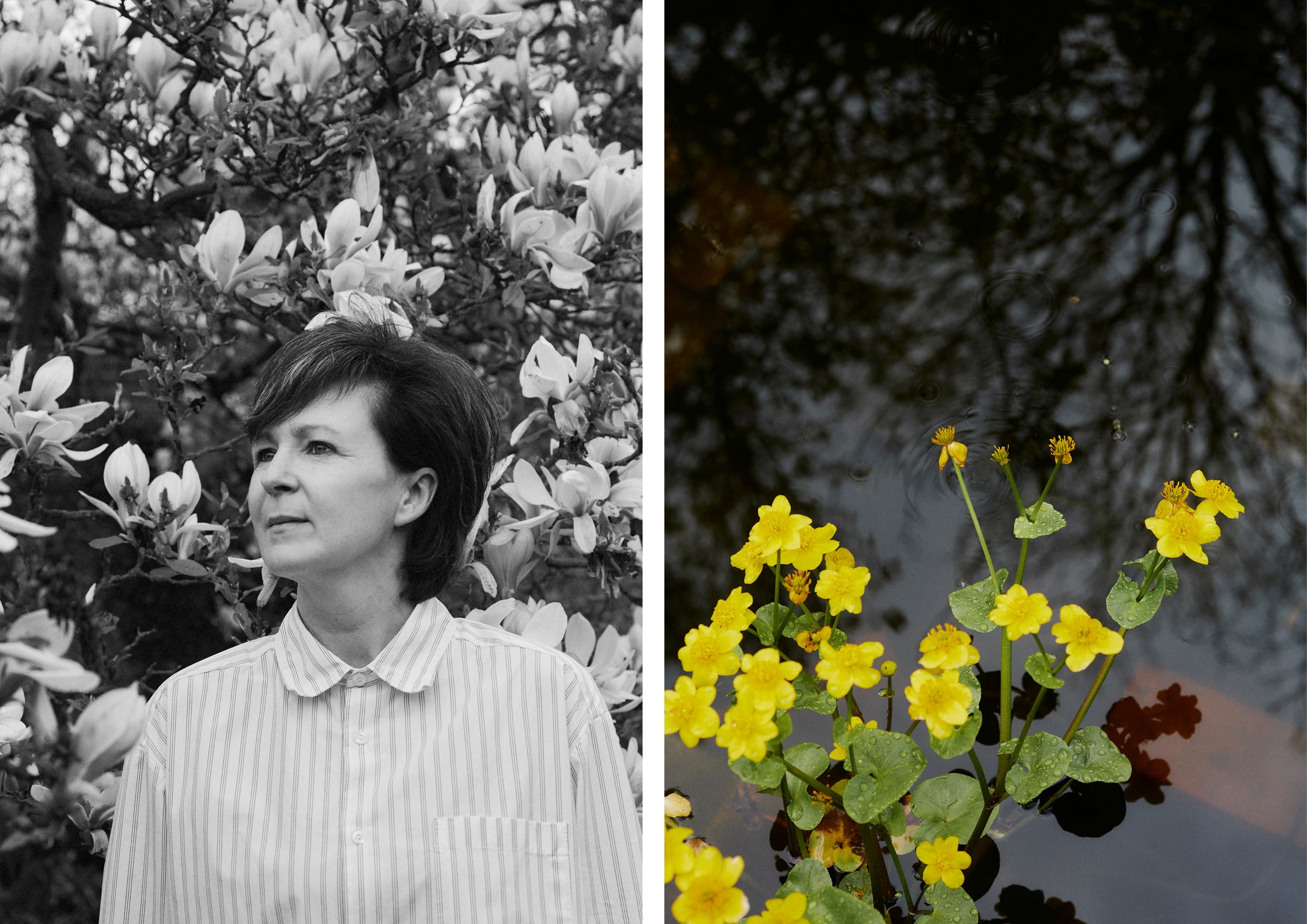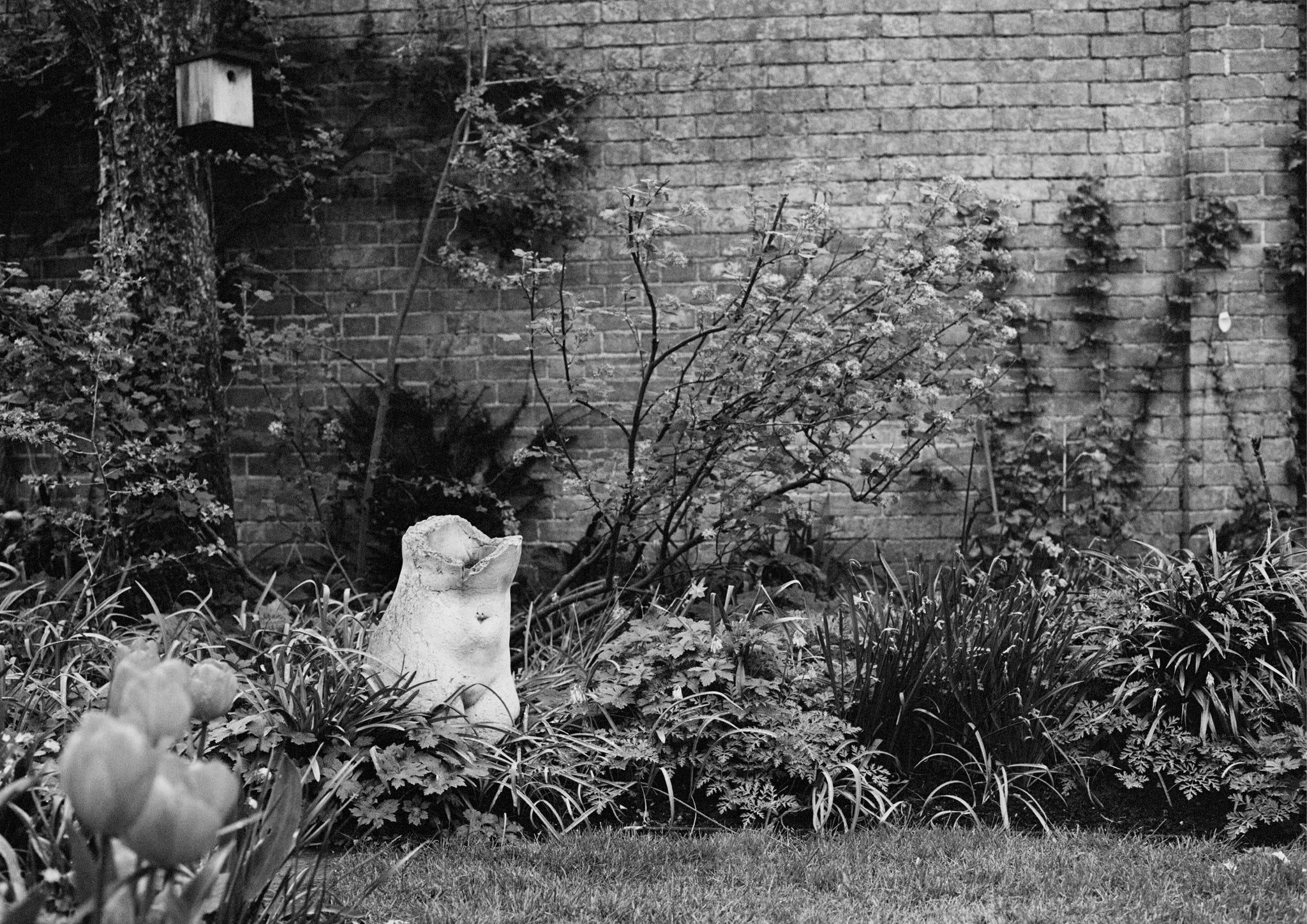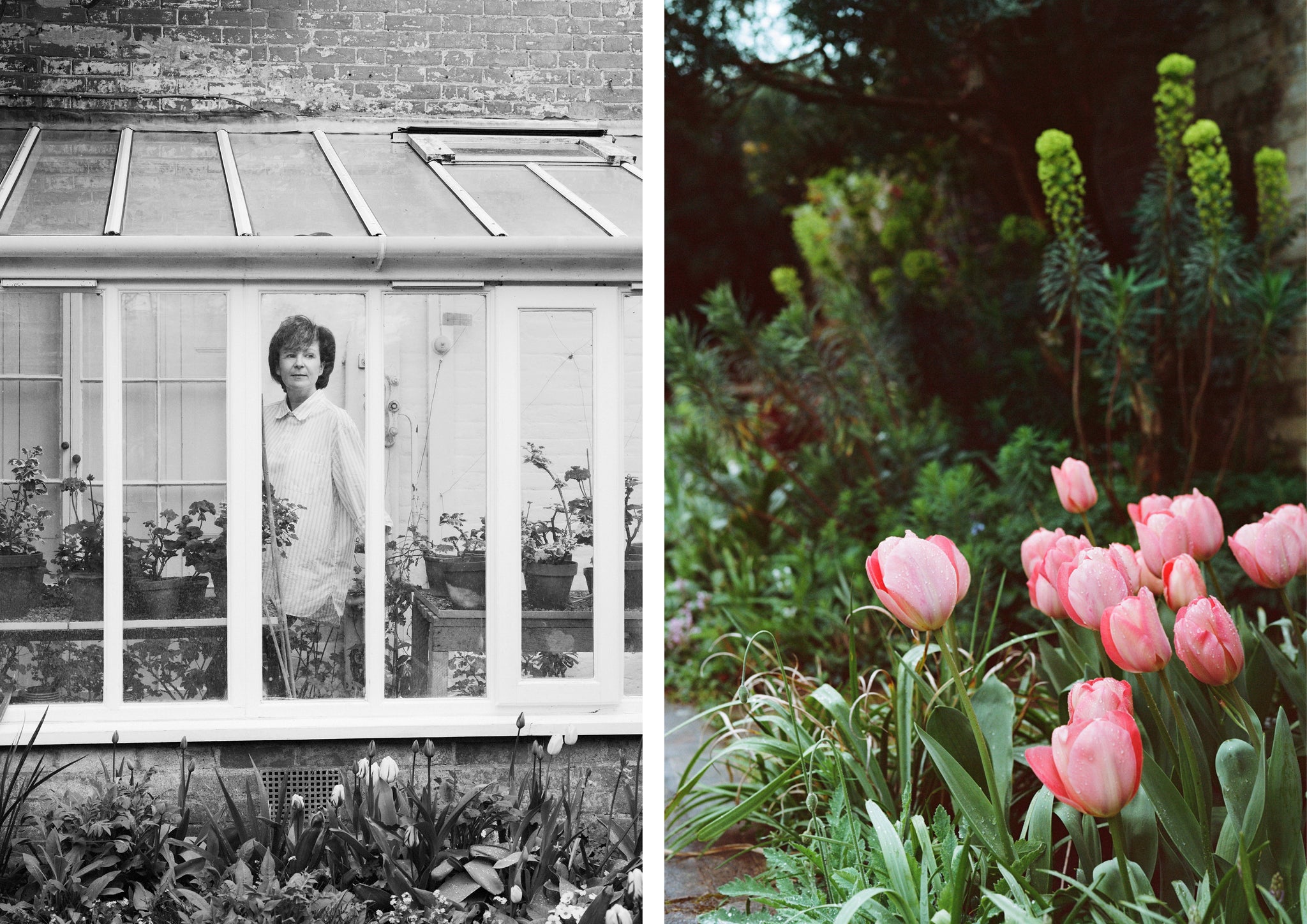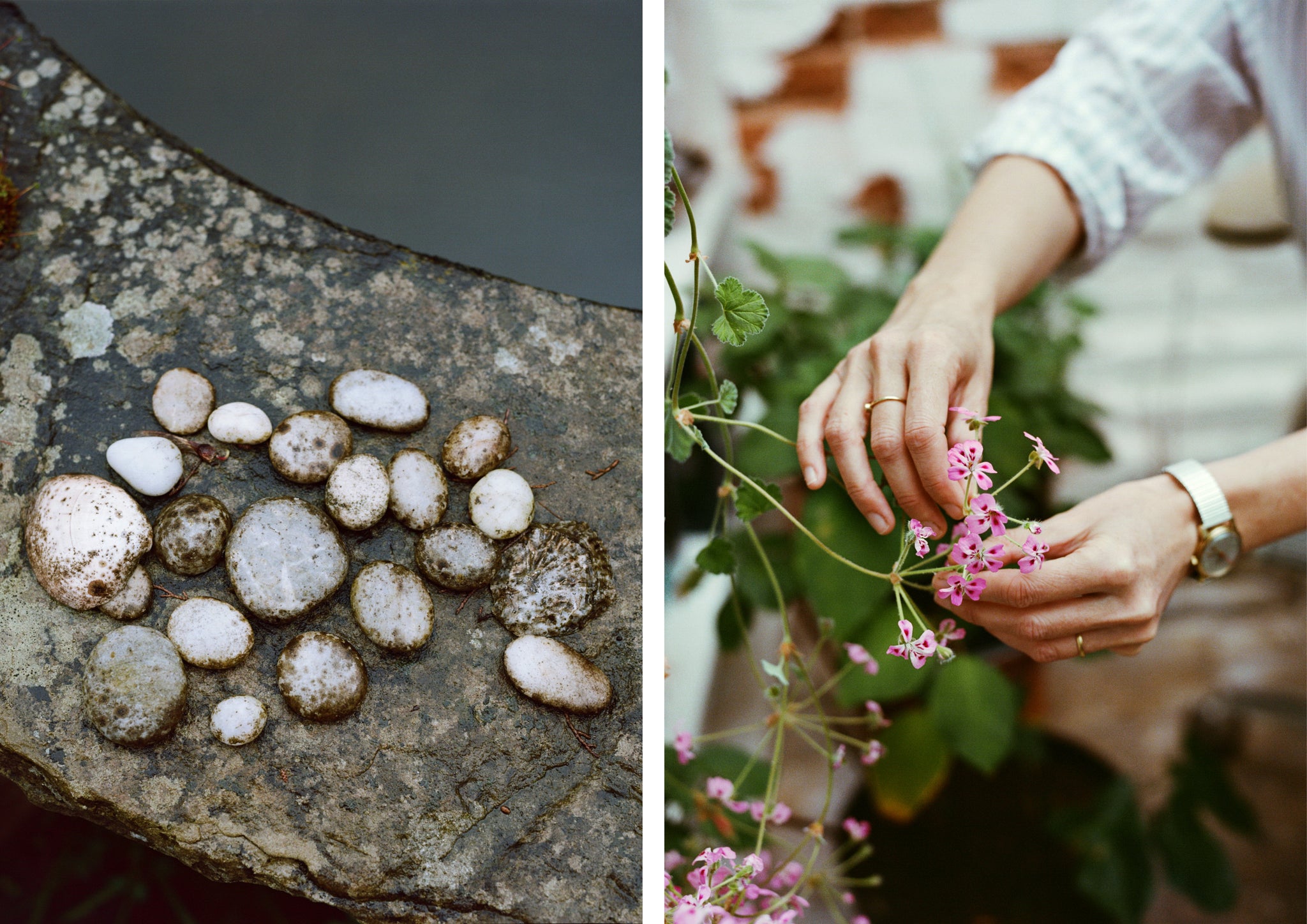
In January, shortly before the first national lockdown in 2020, Olivia Laing went to look at a village house for sale in Suffolk, seven miles from the coast of the North Sea. Its plaster façade was covered in climbing roses planted by an earlier owner, the landscape designer Mark Rumary, who also created the walled garden at the back of the house, a plot that stretches to a third of an acre. Rumary died in 2010, and since his death, the garden had begun to come apart—fruit trees rotted, bamboo filled borders, and ivy thatched across the Suffolk brick walls. Olivia and her husband, Ian, moved into the house in August, and Olivia got to work carefully, weeding and waiting to see what grew throughout the year, taking notes as she went along. The experience of restoring her garden in Suffolk is recounted in her new book, The Garden Against Time, which also considers the wider role of gardens throughout history.
The interview has been edited and condensed for clarity.
Well, so I’m at home in London, listening to paving stones being cut for my next door neighbour’s garden. How are things this morning in Suffolk? When did you get up? Have you eaten?
I got up around seven, had a cup of Assam tea, strong, with milk. And then for breakfast I had what I have every single day of my life. It is so boring and repetitive!

I want to know. This is the stuff of life! What is it?
It is Dorset Cereals Simply Nutty Muesli. I have it with semi-skimmed organic milk. Ideally the milk will be very, very cold and there’s quite a lot of it.
I really don’t like a fancy breakfast. I enjoy something predictable. Before talking to you today, I also had a cup of coffee.
I think you’ve been living in Suffolk, working on the garden, for four years now. Has that time gone quickly?
God, what year is it?
2024
Four years then, yes, coming up on four years. Time went very strange, didn’t it? So in a way it went quickly, but it also sort of felt like infinity for the first two years, because of doing nothing else but being here.
I’ve known Suffolk for about twenty years, and my mum lives here, so I was pretty familiar with this area. But I think that pandemic experience of really being tethered in place means you developed an intimacy with your very immediate surroundings - your walking distance surroundings - like a little circuit, and that was really nice. Normally I’m travelling so much that that wouldn’t have happened, to be able to embed that deeply.

Where are you travelling?
I’m doing book tours. A lot of the time I go to international stuff. I do a lot of research in America. So yeah, I’m on the road a lot of the time.
What are the days like now, before the publicity for this book really gets going?
I’m a very early riser and I rocket straight out to the garden. First thing I’ll drink my tea in bed if it’s raining, but otherwise, it’s straight outside. I will take my bowl of muesli and do a patrol around the beds and that generally leads to “this job needs doing” or “that job needs doing.” So the first two or three hours of each day are outside and then I’ll move inside and start writing. It’s a really nice, languorous workout. It becomes more physical as the hours pass. There’s something very nice about just going straight out and not getting involved with my computer until later in the day.
When you say you’re a very early riser, what kind of time do you mean?
In the summer, it can be four or five in the morning. In winter, it’s like living in a well of darkness in Suffolk, so it’s later, because it feels very, very dark here. Our house isn’t particularly aligned to the sun, and being in a walled garden, that darkness is just very all-encompassing.

And is that what your writing life typically looks like, or does it change between projects?
There are different rhythms. If I’m working on something journalistic then maybe I’m writing over a day or over a week. Whereas if I’m working on a book, that’s a couple of years, so it’s a totally different rhythm. It’s much slower, there’s much more time for reading and research. Because I do such deep archival work for books, there will be periods when I’m on a research trip and just working in archives.
At the moment, I’m in more of a promotional phase, so I’m writing articles and the afternoons are much more computer based. But then, you know, the light will change. I’ll have to go back outside, there’ll be something to check on. So I’m outdoors a lot of the day, which is how I like it. I prefer to be outdoors all the time really.
That first trip outside, that having a look, always blooms into more and more activity. I find it really fascinating. It’s very intuitive. It’s like writing, in a way. Something catches your eye, something doesn’t look right. It needs fixing. So it’s a very parallel activity to writing in the afternoons where I might start by reading through what I’ve written before. See what’s not working, get interested in a problem. And it develops from there. I like that parallel between the two activities.

What about meals and snacks?
I’m a snacker. I like regular meals. I think I have a very fast metabolism. I do need to eat all the time. There’s probably elevenses, probably tea. I will always, always have coffee at 10:30. Very important to have that coffee. And generally, at that point, I’m probably exhausted because I’ve half-started doing something enormous in the garden. So the 10:30 coffee is a welcome break and then I’ll leave it in the garden and it will get cold and I’ll find it later and knock it back. It’s very nice like that. I like the rhythms of the day to be quite marked.
Is there a time during the day when you generally stop working?
It really depends where I’m at in a book. Under normal circumstances, like at the moment where I’m doing more journalism, I’d probably stop around 6pm. Have a glass of wine, move towards the dinner part of the evening.
When I’m writing a book, I’ll work enormous hours. I’ll go back to it after dinner. When I lived alone, I would have a bowl of muesli in the evenings and just carry on. I get very, very immersed at that point. This kind of work I find much easier to set down.
That has been a long process, learning how to put things down at the end of the day. Otherwise you will just burn out. I’ve written seven books now and I don’t want to burn out, so I make myself stop, rest, do something different to switch my mind off, then come back to it the next day, fresh in spirit. I have to be really strict.

And having a partner now, maybe you have to stop at the end of the day so you can chat and cook and all those things too.
Well actually he’s writing a book now, so he’s very grumpy and doesn’t want to talk and needs to go back to things. So I think we take it in turns. But there is a general agreement in the house that we stop and eat meals, and whichever one of us isn’t doing that, the other one will be irritated about it.
Ian is a cook. In the same way that I garden, he loves to cook and cooking is his relaxation. So that’s great for me because I’m not a good cook. I’m a greedy person who can’t really cook. It’s absolutely ideal really, because he gets to go out into a beautiful garden and I get to eat. Actually I probably get the better end of that deal.
In the book, you and Ian very occasionally garden together. Is that a rarity?
Yes, we can garden together under controlled conditions. But I don’t like collaborating. In terms of writing and in terms of gardening, I like to run it on my own. I like to have the vision and then follow it through. I don’t really like being helped. I think some of that is wanting to work in silence and get absorbed. I don’t really want to be chatting.
I’m happy to chat anywhere else but in the garden. I’m very focused. It’s the same as writing. I’m very focused and any disruption is uncomfortable.
So yes, Ian has been edged out. He has his own plot—a herb garden. To be honest, he’s very lazy about it.

Are you working on any gardening projects at the moment?
I’m maintaining the garden at the moment, which, you know, could easily become a full time job. And I haven’t got the time for it to be a full time job, but there is that level of work to be done. So it’s about enriching the planting this year, which is really lovely. The main restoration has been done, but in terms of making it more and more exuberant and elaborate, that’s the project at the moment.
You’ve had a lot of other gardens in your life. Are there plants that you return to?
Yes, there are things that I always plant in every garden, and actually, when we left our old place in Cambridge, I made a list of the plants that I wanted to continue growing, which is probably pretty similar to the plants that I’ve grown in every garden I’ve ever had.
I always grow a Rosa mundi, which is this beautiful, very old rose that’s got striped carmine and white petals. It’s the apothecary’s rose from the 16th century, a real beauty. So planting that would almost be the first thing that I would do in a new garden. Maybe I just very much like stripy flowers, actually, because there’s a stripy tulip called Helmar that I always grow too.
I like to have a quince tree in whatever garden I’m planting. I just think they’re very beautiful, with those lovely, glowing yellow fruits. Lovely blossom in the spring. You know, there are just plants that you feel a friendliness towards.

In the garden in Suffolk, what was the most exciting plant discovery, of something that was already there, or that you knew had been there from the planting notes, and brought back?
One of the things that was very exciting was realising that there were crown imperials in the garden. They’re not a particularly rare or unusual plant, but they come up in this amazing sort of thrusting spike, emerging from the ground. And I was looking at that and thinking, “Oh my God, what’s going to come up?” It gave this sense of bounty beneath the soil. It was very exciting.
That first year of just, each day clocking something new emerging, was very thrilling. Erythronium, dog violets, are very beautiful, and something I’ve never grown before. They have these lovely pendulous, large yellow flowers. And they emerge from absolutely nothing. So you have no sense that they’re there and then suddenly there’s this little colony.
In the book, I think someone gave you the advice not to change anything for an entire year, so you could get a sense of what was already there.
I’m really glad I took that advice. There were a few obviously dying plants that I took out, but I basically did just sit on my hands for a year. There are so many plants that just don’t look very good for months and months, and then they do their thing, and you realise that that one month is so fantastic it’s worth it. And you wouldn’t know unless you were a very patient. I’m not a patient person, but I obeyed that really religiously.

And you were keeping a detailed diary about what was coming up—do you always keep a diary?
They go in and out. The diary for this book was seven notebooks long, written over about two years. It would be late at night, I’d be covered in mud and really forcing myself to write it all down. Because I didn’t want to write it down. I just wanted to live it. And I’m glad of it now because it’s such a detailed record.
During that period, I wasn’t really writing the book at all. I was just doing the gardening, keeping the diary, and then it’s the process of transcribing it and working out how the larger story fits in and how I can keep the thread of the garden running through the whole book.
The garden restoration is a through line in your book, but it’s only one part of the story, which is a wider exploration of the role of gardens in history. Did working in this garden inspire you to write the book, or were you planning to write this book already, and then you happened to land in this garden in Suffolk?
I was going to write this book already, and then happened to land in this garden. If I had happened to land in a different garden, there would have been a different sort of overarching story about what I was restoring and what it looked like, but the political and structural elements that explored the problems of that type of exclusive and exclusionary paradises, and the renegade Edens through time—that was always going to be the story.
It's a subject I’ve been interested in since I was living in road protests in the 90s. The core story that I’m most interested in is landscape, ownership, utopia, reclamation—all of those things are big drivers of my life and my writing. But I wanted to be able to tell that story in a way that felt beautiful, in a way that felt like a haven for the reader.
In this very binary, divisive political moment, I wanted it to feel as if you could come in and be held and then listen to and think about difficult ideas in a safe environment. You know, I have very left wing politics, but I wanted somebody who had different politics to be able to read it and reflect on it without feeling like they were being screamed at. So that’s why the beauty is really foregrounded. That’s why it was very important to have that almost a spell of language, and feel that you as a reader were being invited into the space in a really welcoming way.
The language does draw you in. I wrote down so many new words while reading the book.
The richness of botanical language and old botanical language is so alluring, isn’t it? A friend of mine was saying that when she read it, it was like listening to the Shipping Forecast, and that she didn’t really understand what a lot of it meant, but it didn’t matter, she found it soothing anyway.
Are you reading anything for pleasure right now?
I’ve just finished Lightning Rods by Helen DeWitt, which I’d been meaning to read for at least a decade. It was spectacular. That was a real pleasure. I’ve been travelling a lot so I’ve been reading on planes and trains and I couldn’t stand another trip staring at my laptop so I grabbed it sort of at random from the shelves and it’s electrifying. It’s a very, very witty, bleak fantasy about American labour and sex. It’s brilliant.
Olivia wears the Flower Mountain Yamano Kaiso Trainers.
The Garden Against Time by Olivia Laing is out now.
Words by Jo Rodgers.
Photography by Aloha Bonser-Shaw.
Add a comment
4 comments